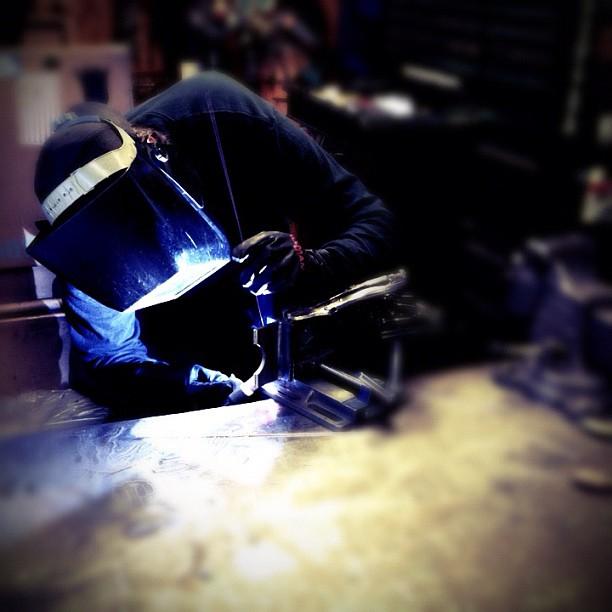Owner, Brown Dog Welding
- FMA
- The Fabricator
- FABTECH
- Canadian Metalworking
Categories
- Additive Manufacturing
- Aluminum Welding
- Arc Welding
- Assembly and Joining
- Automation and Robotics
- Bending and Forming
- Consumables
- Cutting and Weld Prep
- Electric Vehicles
- En Español
- Finishing
- Hydroforming
- Laser Cutting
- Laser Welding
- Machining
- Manufacturing Software
- Materials Handling
- Metals/Materials
- Oxyfuel Cutting
- Plasma Cutting
- Power Tools
- Punching and Other Holemaking
- Roll Forming
- Safety
- Sawing
- Shearing
- Shop Management
- Testing and Measuring
- Tube and Pipe Fabrication
- Tube and Pipe Production
- Waterjet Cutting
Industry Directory
Webcasts
Podcasts
FAB 40
Advertise
Subscribe
Account Login
Search
A welder’s hands and eyes
- By Josh Welton
- September 11, 2014
It’s a comment I get a lot in regards to my welding: “You must have steady hands and great eyes!" The truth is, I've got neither. I'm legally blind in my left eye, I'm nearsighted, and I've got horrible double vision. The more I wear glasses, the quicker the sight goes downhill, so I don't often put them on. I've thought about laser surgery, but considering the amount of time I spend looking at a weld pool, I'm a little nervous about light sensitivity. So, no, I don't have great eyes.
And I remember back to my first welding class at Macomb Community College, when I was an apprentice at Chrysler. Before we got into TIG welding, we did a little bit of oxyacetylene welding. The instructor did a demo for us: torch in the right hand, filler in the left hand, both extended far from his body. And he put down an even, consistent, 6- to 7-in. bead. Steady as a rock. I recall turning to a fellow apprentice and saying, "If you've got to be that steady to weld, I'm out." I shake like a leaf. Always have. I'm sure my penchant for Monster and Haribo gummies doesn't help the situation, but that's neither here nor there.
So from the start I've used every trick I could pick up to mask my shortcomings. With the eye issues, there's only so much you can do. I've learned that "vision" and “eyesight” are two different things. With 20/20 sight there's no interpretation, no gray area; what you see is what you get and you can attack it. But vision has added elements of anticipation, of making educated guesses ... of feel. So I depend on my vision much more than my eyesight. To be honest, it's not always the perfect compensation, but if given the choice, I'd much rather have pure vision than perfect eyesight.
On to the steady hand. I once worked with a journeyman who told me a bit about how he was trained. When he was taught to weld, his instructor told him to be as "uncomfortable as possible" when practicing, because then he could weld in any situation. What a flawed concept! And it was proven out by his pupil, who was not a good welder. Yes, you're gonna be put in some awkward positions and you'll be expected to perform. But no matter whether I was in a swaying boom lift repairing an overhead door with a stick welder; flat under a car pushing the TIG pedal with my knee; lying on my back pulse MIG welding under an 80-ton tank; or upside down in a stainless washer welding with a mirror while my partner held a shield in front of my face because my helmet wouldn't fit through the opening, I got as comfortable as possible in that situation. Once you become oriented, welding is welding, and your training/experience will take over.
Think about stick welding. You've got a stinger, then an electrode beyond that. Any uneasiness in your legs goes into your body, then goes through your arms, your hands, then the stinger, then the electrode ... and it's amplified the farther away it gets from the source. Even a little twitch in your hand is going to be a big twitch at the business end of the stick.
The closer you can rest your hands, arms, and body to the workpiece, the better off you'll be. Obviously, this is harder to do in some circumstances than others, but don't be afraid to think outside of the box. I've even seen guys take brooms and place them against the pipe they're welding on in order to have something to lean against. I'll take vise grips and attach them close to the work area to rest a hand or arm on. When welding under the tank, I grabbed a tall 90-degree angle block to lean one of my outstretched arms on, which helped steady both.
Outside of that, a proper stance helps as well. Like a MLB hitter in the batter's box or a boxer in the ring, find a stance that keeps your body balanced. As you work your way up from there, keep your elbows tucked in as much as possible and your arms in line with your body. These general ideas work for any type of welding, although with TIG you've got the additional problem of keeping the filler rod steady, and, in many cases, operating the foot pedal as well.
If I'm sitting at a bench TIG welding, I don't need to worry about my lower body. The main things to keep steady are my arms and hands. I keep the work as close to me as possible, and I keep my elbows tucked in to my side.
When you're using a long piece of filler rod, a wobble at the back end can make it more difficult to control the other end at the puddle. I don't often do it anymore, but a trick I was taught back in the day was to bend a 2- to 3-in. section of the rod to a 90-degree angle, at the opposite end of where you're melting it. The bent end would always be weighted in the "down" position, and it would keep the rod steady instead of flipping around.
Another option is to actually tuck the rod between your arm and your body, holding it steady. But I usually just hold the rod with my fingers, "pinching" it, giving it tension so that it presses against my arm, rather than letting it float in space.
When possible, I rest the wrist of my torch hand as close as I can to where I'm welding. Sometimes I'll just hold the torch with my thumb and forefinger, using my pinky and ring finger to steady myself against the work surface. In any type of welding, the closer you can get your hands to the arc, the steadier you can be. The closer you can rest your hands or arms against a solid surface, the steadier you can be. It's not always possible to be that close, but it's the general idea. Closer = steadier.
However, there is a downside to resting your torch hand that close to the weld: It increases the difficulty in making a long pass. When I TIG weld, my fingers, hand, wrist, and arm must move in sync to keep the torch angle and arc length consistent as I creep my torch hand along the weld. There are many more moving parts, and a greater chance to screw up than if you're able to hold your torch hand above the workpiece and use your arms and body to "rotate" down the weld, or slide, almost as if on rails. If you're steady enough to do the latter, it's the way to go. I'm not, so I improvise with the former technique when I can.
So even if you can't see that well, and you don't have that steady of a hand, you shouldn't let that get in your way. Maybe you have to resort to an unconventional method or two, but if that's what it takes, so be it.
subscribe now

The Welder, formerly known as Practical Welding Today, is a showcase of the real people who make the products we use and work with every day. This magazine has served the welding community in North America well for more than 20 years.
start your free subscriptionAbout the Author

About the Publication
- Stay connected from anywhere

Easily access valuable industry resources now with full access to the digital edition of The Fabricator.

Easily access valuable industry resources now with full access to the digital edition of The Welder.

Easily access valuable industry resources now with full access to the digital edition of The Tube and Pipe Journal.
- Podcasting
- Podcast:
- The Fabricator Podcast
- Published:
- 04/16/2024
- Running Time:
- 63:29
In this episode of The Fabricator Podcast, Caleb Chamberlain, co-founder and CEO of OSH Cut, discusses his company’s...
- Industry Events
16th Annual Safety Conference
- April 30 - May 1, 2024
- Elgin,
Pipe and Tube Conference
- May 21 - 22, 2024
- Omaha, NE
World-Class Roll Forming Workshop
- June 5 - 6, 2024
- Louisville, KY
Advanced Laser Application Workshop
- June 25 - 27, 2024
- Novi, MI


































